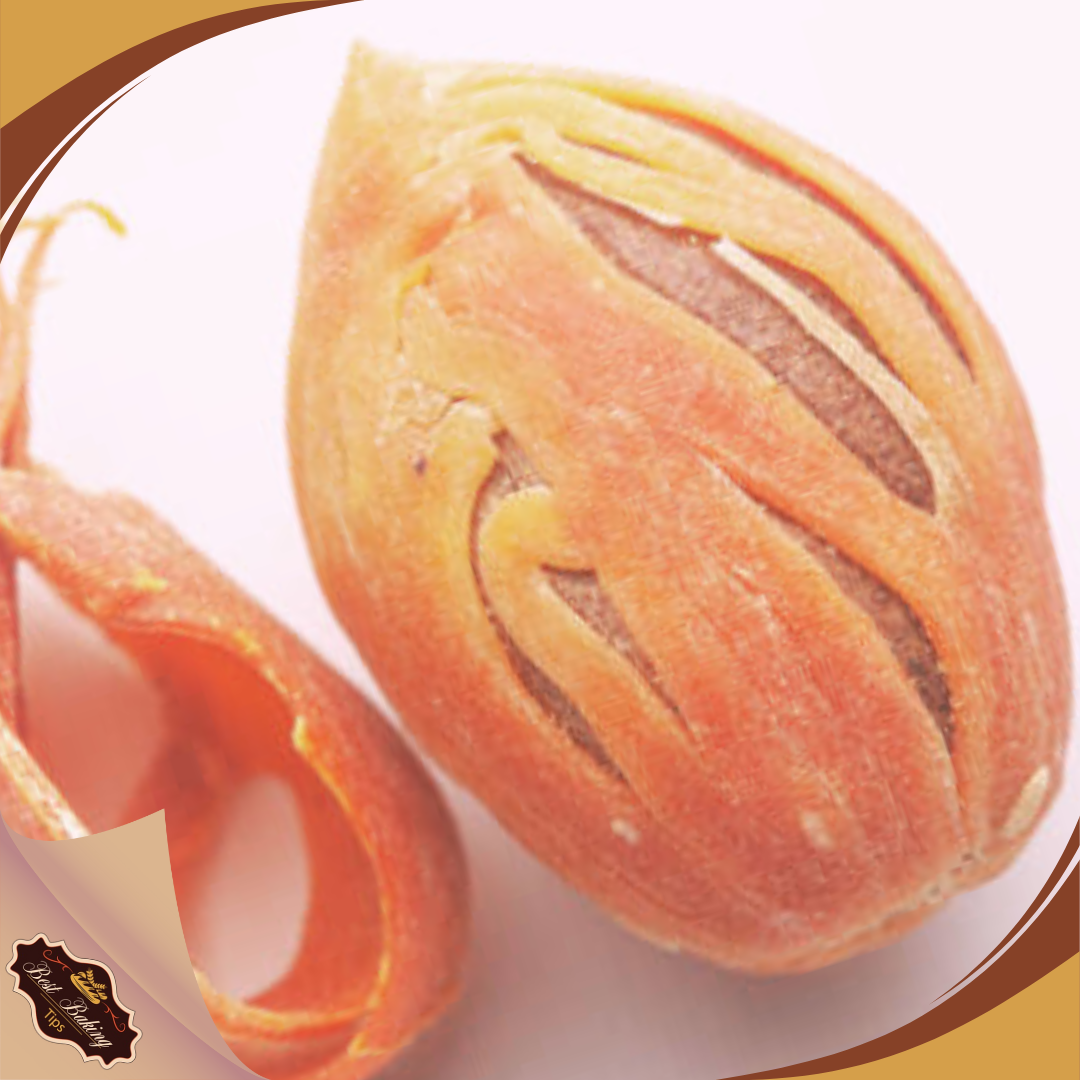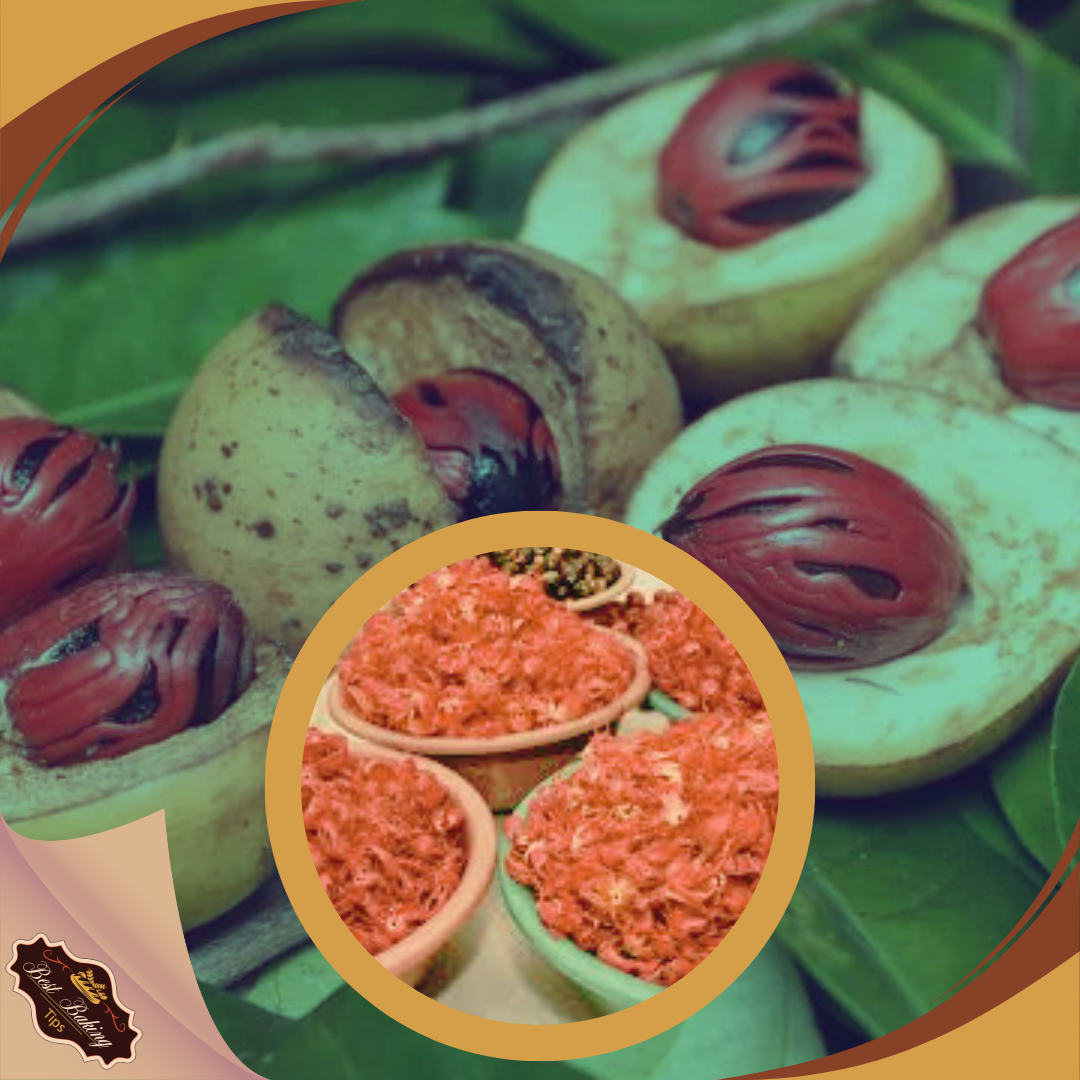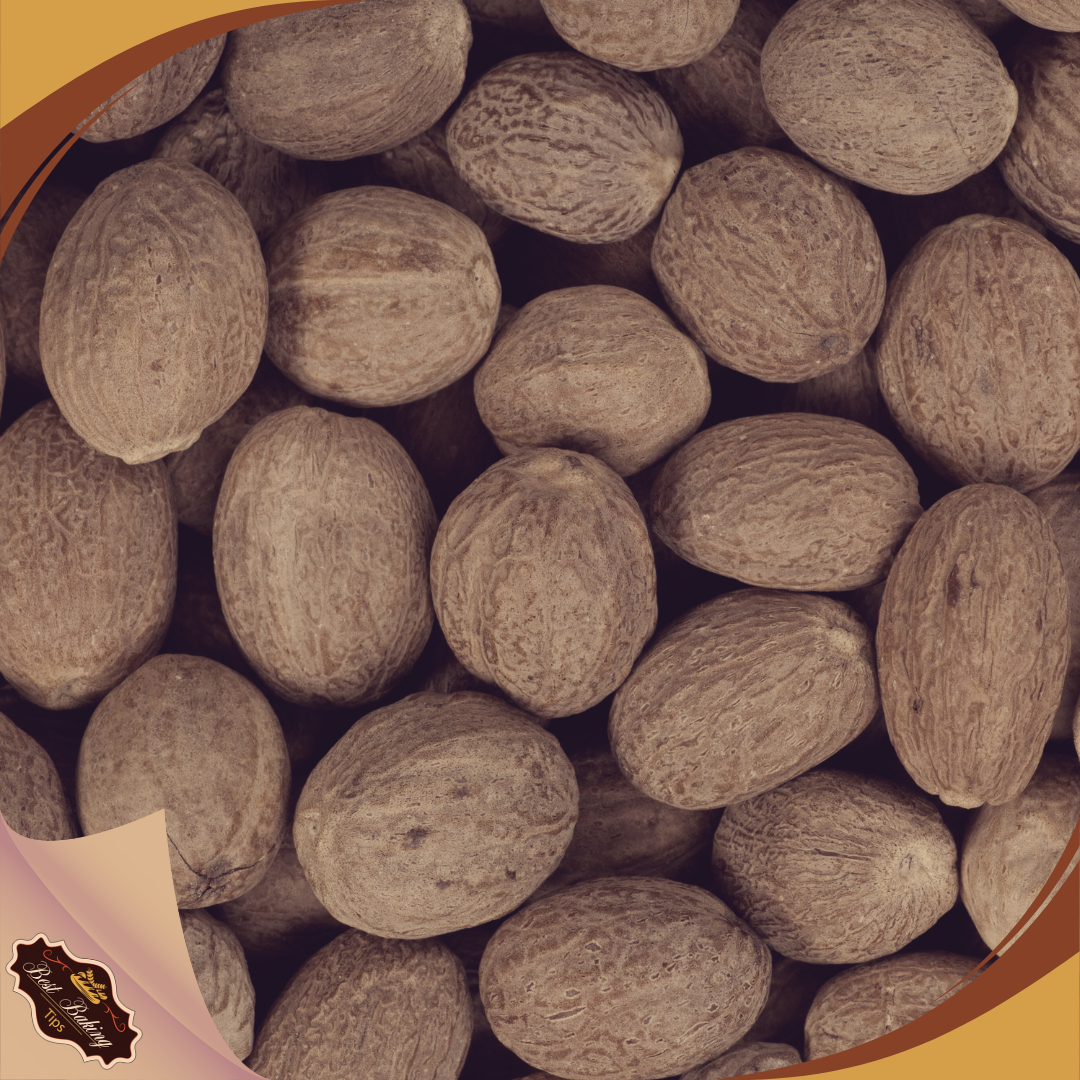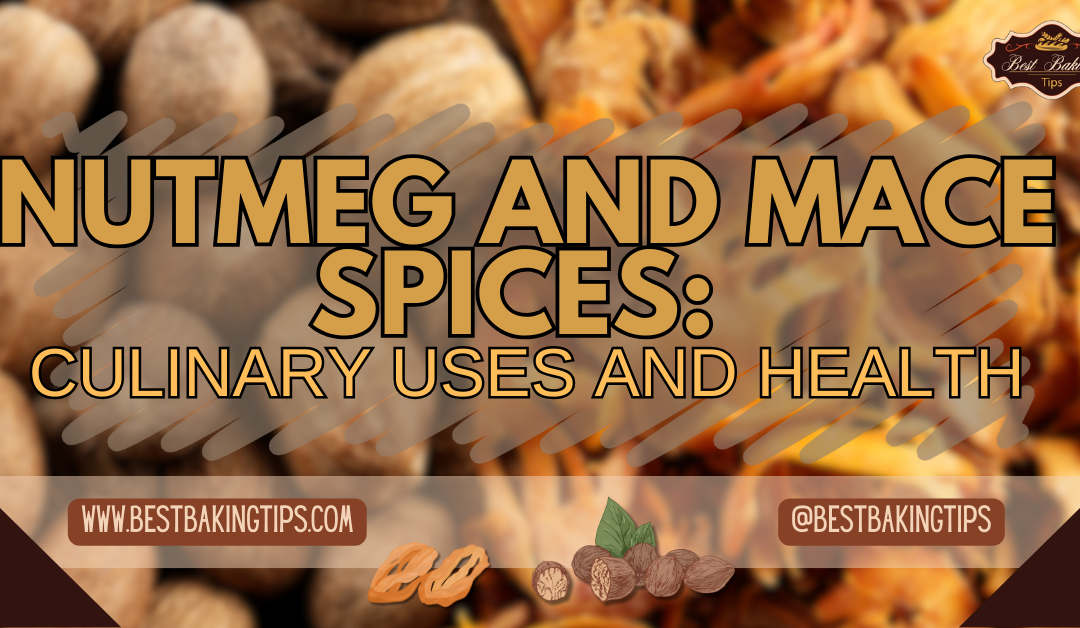==================
Affiliate Statement
Best Baking Tips is supported by our audience. When you purchase through one of our links, we may earn a small affiliate commission. As an Amazon Associate I earn from qualifying purchases. Your cost is not affected.
==================
Nutmeg and mace spices’ journey from the historic Spice Islands to global kitchens is a flavorful saga of culinary richness and botanical marvel.
Ready to spice things up? We’re diving into the captivating world of nutmeg and mace spices, where history, flavor, and wellness collide. From ancient tales to modern-day marvels, these culinary gems have a story to tell. So, grab a seat and get ready to uncover the secrets of nutmeg and mace. It’s a flavorful adventure you won’t want to miss!
Nutmeg and Mace Spices: Culinary Uses and Health Benefits
Nutmeg and mace are two distinct yet closely related spices that hail from the same evergreen plant, Myristica fragrans.
Originating from the Banda Islands in Indonesia’s Moluccas archipelago, known historically as the Spice Islands, these spices have traveled across the world and are now a staple in kitchens and cuisines globally.
Nutmeg, the seed of the fruit, and mace, the lacy aril that envelops the nutmeg seed, both carry a warm, slightly sweet, and potent flavor that is versatile in use.

Both nutmeg and mace play a significant role not just culinarily but also in historical trade and health.
The cultivation and processing of these spices are intricate and have remained largely traditional over the centuries.
Their valuable and distinctive taste has been the reason for their high demand, which historically led to trade disputes and even conflicts.

Today, I find it interesting that nutmeg and mace continue to be sought after for their culinary versatility, distinct flavors, and the depth they add to sweet and savory dishes alike.
They are also valued for their composition, which includes essential oils and compounds that contribute to their unique sensory profiles and potential health benefits.
Key Takeaways
- Nutmeg and mace come from the same plant and have a rich history and culinary value.
- Their cultivation and processing require skill, maintaining traditional methods.
- These spices contribute unique flavors and potential health benefits to dishes.

Botanical Overview
Nutmeg and mace are significant for their culinary and medicinal applications. Their botanical characteristics are fascinating, and understanding their taxonomy and plant structure deepens appreciation for these spices.

Origin and Taxonomy
I’m aware that nutmeg and mace originate from the Spice Islands, also known as the Banda Islands, located in the Moluccas region of Indonesia.
These aromatic spices are derived from the Myristica fragrans tree, which is the only plant species that produces both a spice and a spice derivative.
To clarify the taxonomy:
- Kingdom: Plantae
- Order: Magnoliales
- Family: Myristicaceae
- Genus: Myristica
- Species: M. fragrans
Plant Morphology
The nutmeg tree is an evergreen species that can grow to a significant height, typically reaching up to 20 meters.
I recognize that it possesses dark green, lanceolate leaves and small, pale yellow flowers which are the precursors to the fruit.
The fruit of the Myristica fragrans tree is peach-sized, which upon ripening, splits open to reveal a dark brown seed (the nutmeg) enveloped by a bright red aril (the mace). The tree’s notable features include:
- Height: Up to 20m
- Leaves: Dark green, lanceolate
- Flowers: Pale yellow
- Fruit: Peach-sized, splitting open at maturity
- Seed: Dark brown (nutmeg)
- Aril: Bright red (mace)
Historical Significance
In my exploration of the past, I’ve come to understand that nutmeg and mace offer more than just flavor; they represent a saga woven into human history. My focus is on their ancient applications and the immense economic effects that stem from their trade.

Ancient Uses
The historical roots of nutmeg and mace are deep, with grounding in ancient civilizations.
On the Indonesian islands, I uncovered evidence that these spices were once integral to local traditions. Moreover, their influence spread rapidly—as I learned, they were embraced for their medicinal properties in India and China, and later, these spices became staples in European medieval cuisine.
Trade and Economic History
The trade history of nutmeg and mace is a resonant testimony to their value.
I’ve come across accounts that show how these spices prompted European powers to embark on expansive maritime explorations, aiming to find the fabled Spice Islands.
The intense competition for control over the spice trade led to full-fledged conflicts, which I acknowledge had significant geopolitical ramifications.
Notably, the Dutch attained a monopoly over these spices in the 17th century, which became a cornerstone of their economic might during the era.
This monopoly had implications so vast that it fundamentally shaped the commerce and politics of the age.
Cultivation
In my exploration of nutmeg and mace, I’ve discovered that the techniques and regions involved in their cultivation are pivotal to the quality and sustainability of these spices.

Growing Regions
I have found that nutmeg trees, which produce both nutmeg and mace, thrive in tropical climates with rich, volcanic soil.
They grow predominantly in the Banda Islands—also known as the Spice Islands—of Indonesia. The Caribbean also contributes significantly, with Grenada being notably called the ‘Island of Spice’.
Harvesting Techniques
I understand that nutmeg trees take seven to nine years to bear fruit, but once they do, they can produce for up to 60 years.
Harvesting involves collecting the mature fruit, which splits open to reveal the aril-covered seed.
The aril is mace, which is carefully separated from the seed—the nutmeg.
Both are dried before being sold, with drying nutmeg taking approximately six to eight weeks.
Sustainable Practices
I’m keenly aware that sustainable practices in spice cultivation are essential for long-term viability.
Nutmeg production now often includes organic farming, intercropping, and fair trade initiatives.
These practices ensure soil health, protect biodiversity, and improve the livelihoods of farmers.
Organic certifications are increasingly common for both nutmeg and mace, assuring consumers about the absence of synthetic inputs in farming.
Processing and Production
In the processing and production of nutmeg and mace, dedicated procedures ensure that the spices meet commercial standards while retaining their distinctive flavors. I will walk you through the critical stages, from extraction to packaging.

Extraction of Spices
Nutmeg and mace are derived from the fruit of the Myristica fragrans tree.
The nutmeg seed is encased by a bright red aril, which becomes mace upon drying.
I ensure that the extraction process includes drying the nutmeg seeds carefully, then separating mace from the nutmeg.
To produce one pound of dried nutmeg, I utilize roughly two pounds of the green nutmeg.
Sorting and Grading
Sorting and grading are pivotal steps that determine the quality of the final product.
I focus on inspecting the spices by size, weight, and aromatic profile to categorize them into grades.
Nutmegs and mace that pass specific quality checks go onto the next stage, with superior quality mace having a vibrant aroma and robust structure, while lower grades may exhibit a more brittle texture and subdued scent.
Packaging Standards
Lastly, the packaging standards I follow are established to maintain the spices’ integrity during transit and storage.
I adhere to regulations that require packaging to protect against moisture, light, and contamination, using materials that preserve the spices’ essential oils and aroma.
Nutmeg and mace are often vacuum-sealed and may include oxygen absorbers to prolong shelf life. These methods are crucial in delivering the high-quality spices consumers expect.
Nutritional Composition
hen evaluating the nutritional profiles of nutmeg and mace, I am particularly attentive to their essential oils and bioactive compounds, both of which contribute to their health benefits and unique flavors.

Essential Oils
Nutmeg and mace are rich in essential oils, which are responsible for their distinct aromatic qualities.
For instance, nutmeg oil consists of components like myristicin and eugenol.
Myristicin is known for its psychoactive properties, while eugenol serves as an antioxidant and has antimicrobial effects.
Bioactive Compounds
The bioactive compounds in nutmeg and mace, such as lignans, phenolics, and flavonoids, are highly regarded for their potential health benefits.
Flavonoids, for example, have been attributed with anti-inflammatory effects.
It is these compounds that not only enhance the flavor profile but also contribute to the health-promoting characteristics of both spices.
Culinary Uses
Nutmeg and mace are both derived from the fruit of the Myristica fragrans tree and offer a range of uses in the kitchen. I’ll walk you through their distinct flavor profiles, complementary pairings, and the role they play in global cuisines.
Flavor Profile
Nutmeg is renowned for its warm, nutty, and slightly sweet flavor, with subtle notes that can remind one of mint or cardamom.
Mace, being the outer covering of the nutmeg seed, has a similar taste profile but is often considered to have a sharper and more intense aroma.
It is also common to substitute mace for nutmeg at a ratio of one quarter, due to mace’s stronger flavor which can be found in this What Is Nutmeg and Mace article.
Culinary Pairings
Both spices are incredibly versatile, but they shine in different pairings:
- Nutmeg:
- Sweet dishes: Puddings, pies, and pastries.
- Savory dishes: Cream sauces, soups, and meat seasonings.
- Mace:
- Sweet dishes: Offers a piquant edge to cakes and dessert recipes.
- Savory dishes: Perfect for flavoring meat, stews, and curries.
Incorporating the correct amount can enhance both sweet and savory dishes exponentially.
Global Cuisine Contributions
My knowledge shows that nutmeg and mace have made significant contributions to cuisines worldwide:
- European cuisine: Nutmeg is often a key ingredient in Italian pesto, British mashed potatoes, and Dutch cheeses.
- Asian cuisine: In Indonesia, the birthplace of nutmeg and mace, they are used in spicy meat dishes and traditional sweets.
- Caribbean cuisine: Mace and nutmeg both feature in island recipes, from jerk seasonings to sweet desserts.
Understanding how nutmeg and mace influence different International dishes provides an avenue for exploring and appreciating cultural culinary diversity. The article on How to Cook With Mace gives insight into their versatility and global culinary impact.
Health Benefits
In my exploration of nutmeg and mace, I’ve discovered that these spices are not only prized for their distinctive flavor but also for their potential health benefits. They have been traditionally used to aid digestion, alleviate pain, and even have cognitive effects.

Digestive Health
I’ve learned that mace is known for its digestive benefits. It has been shown to help improve digestion and can be beneficial in relieving nausea, vomiting, and diarrhea.
On the other hand, nutmeg is effective in promoting digestion and relieving gas thanks to its fiber content.
Pain Relief
For pain relief, I found that the oils contained in mace, such as myristicin and eugenol, have analgesic properties. This means that mace can be used to alleviate pain, including toothache and muscle pain.
Similarly, nutmeg has also been recognized for its analgesic effects and is believed to help ease joint and muscle pain.
Cognitive Effects
Regarding cognitive effects, studies suggest that nutmeg’s compounds may exert beneficial effects on the brain. It can help to reduce anxiety and depression symptoms to some extent. However, it’s important to note that high doses of nutmeg can be psychoactive and potentially harmful, so it’s crucial to use this spice in moderation.
Safety and Side Effects
n this section, I’ll provide important safety information and potential side effects associated with the consumption of nutmeg and mace.
Recommended Dosages
Nutmeg:
Typically, culinary use of nutmeg is considered safe, with general use amounting to a pinch or a dash in recipes.
For medicinal purposes, a common dose is up to 120 mg per day.
Mace:
Mace is usually used in smaller quantities than nutmeg, given its more potent flavor. The recommended safe amounts mirror those of nutmeg due to their similarities.
Italics are used for emphasis on specific terms.
Potential Interactions
Nutmeg and mace may interact with certain medications:
- Anticoagulants: These spices could potentiate the effects of blood thinners.
- Sedatives: Nutmeg and mace may increase the sedative effects of certain medications and supplements.
Toxicity Information
Nutmeg:
Excessive consumption can lead to symptoms such as confusion, palpitations, and nausea.
As little as 2 teaspoons can be toxic and should be treated with caution.
Mace:
Similar to nutmeg, high doses of mace can also cause adverse effects such as hallucinations, dizziness, and vomiting.
Keep in mind that individual tolerance levels may vary, and it’s essential to adhere to recommended dosages.
Market and Trade Data
In this section, I discuss the latest figures and insights that shape the market and trade landscape for nutmeg and mace.
Global Production Statistics
Global production statistics for nutmeg and mace reveal that these spices are not just culinary staples but also significant commodities in the agricultural export economies of several tropical countries.
For example, data indicates that by 2018, the worldwide market for spices had already surpassed $6.5 billion annually, with nutmeg playing a notable role in contributing to this figure.
Trade Regulations
Trade regulations play a crucial role in the export and import of nutmeg and mace.
Stricter quality control, safety standards, and geopolitical relationships can have profound effects on the flow of these spices between countries. Regulations can be influenced by factors like crop health and the push for sustainable farming practices.
Market Trends
The nutmeg market size is estimated to continue growing, with predictions for its value to increase at a Compound Annual Growth Rate (CAGR) of 5.5% from 2024 to 2029.
The burgeoning popularity of Asian cuisines in the West and their associated spices, such as nutmeg, has been identified as a significant driver of this growth.
Additionally, the latest trade data of Nutmeg, mace, and cardamons has shown that despite a year-on-year decrease in exports, these spices remain a critical component of global trade.
Research and Developments
In recent years, significant progress has been made in the study of nutmeg and mace, with a focus on their medicinal properties and the optimization of extraction methods to harness these benefits efficiently.
Recent Studies
Results from recent pharmacological research sheds light on the therapeutic potential of nutmeg, recognizing its historic use for gastrointestinal disorders and pain management.
Notably, contemporary research focuses on its ability to manage rheumatic pain and its calming effects.
For instance, the benefits of nutmeg in treating gastrointestinal disorders and managing pain are well documented, as shown in the study published in PubMed Central.
Innovative Extraction Techniques
The method of extracting essential oils from nutmeg and mace has experienced notable refinements.
These advancements aim not only to improve yield but also to preserve the delicate aromatic compounds and medicinal properties. Techniques like supercritical fluid extraction are at the forefront due to their efficiency and eco-friendliness.
Future Prospects
Looking forward, the focus seems shifting towards sustainable sourcing and improving the nutritional profile of nutmeg and mace.
Researchers continue exploring the potential for these spices to combat dietary-related health issues, with growing interest in their role in preventing metabolic disorders.
Evidence of the nutritional and health benefits of nutmeg is available in articles such as those found on ScienceDirect.
Nutmeg and Mace Spices: Exploring Flavorful Horizons
And that ends our discussion on the fascinating world of nutmeg and mace spices! We’ve explored their rich history, culinary versatility, and potential health benefits. From ancient origins to modern kitchens, these spices have left an indelible mark.

We’re grateful for your company on this flavorful adventure! Before you go, we’d love to hear from you. What are your favorite spices, and has nutmeg ever added its magic to your dishes or wellness routines? Share your thoughts with us!
Thanks for your time with us, and may your culinary creations always be seasoned with spice and joy!
Frequently Asked Questions
In my exploration of spices, I gathered some of the most commonly asked questions about nutmeg and mace to provide clear, concise answers for culinary enthusiasts and cooks alike.
What are suitable substitutes for nutmeg and mace in recipes?
If you’re out of nutmeg, good alternatives include cinnamon, ginger, or allspice, each of which can impart a warm flavor to dishes.
Conversely, if mace is unavailable, a bit of nutmeg or allspice can be used to achieve a similar taste profile in curry powders or other spice blends.
How can nutmeg and mace be incorporated in cooking?
Nutmeg is versatile, adding a sweet and nutty note to desserts, beverages, and savory dishes alike.
Mace, while similar, carries a more intense flavor suitable for meats, sauces, and baking, enhancing dishes with its peppery and slightly sweet nuances.
What distinct benefits do nutmeg and mace offer?
Both spices offer a range of benefits beyond flavor. Nutmeg has been associated with digestive health, while mace can provide antioxidant properties and aids in appetite regulation. Each spice contributes to the layers of flavor and healthful properties in the dishes they season.
What is the difference between mace and nutmeg?
Though they come from the same plant, mace and nutmeg show distinct characteristics; mace is the aril, the lacy coating on the nutmeg seed.
Their flavors taste similar, yet mace is slightly more pungent and spicier, while nutmeg has a softer, sweeter profile. We use both, either together or separately, to enhance flavor in sweet and savory dishes, but with distinct sensory nuances.
In what ways are mace and nutmeg interchangeable in recipes?
Mace and nutmeg sometimes substitute for each other due to their similar flavor profile.
In recipes where one is called for, the other often works well with adjustments in quantity to ensure the right balance of flavor is maintained.
What proportion of mace is equivalent to nutmeg in culinary use?
When substituting in recipes, mace has a stronger flavor, so I recommend using a quarter of the amount of mace when replacing nutmeg.
For every teaspoon of nutmeg required, use just a quarter teaspoon of mace to achieve a comparable flavor.
Connect with Us for Plant-Based Baking Bliss!
For delightful plant-based baking inspiration, engaging content, and product reviews, follow us on our social media platforms:
- Find us on Facebook for tasty recipes and baking tips!
- Dive into our visual feast on Instagram for mouthwatering photos and behind-the-scenes peeks.
- Discover endless baking ideas and pin your favorites on Pinterest.
- Stay updated with the latest baking trends and news by following us on Twitter.
- Join the fun and watch our baking adventures unfold on TikTok!
Connect with our passionate community of plant-based baking enthusiasts and let’s create delicious treats together!





